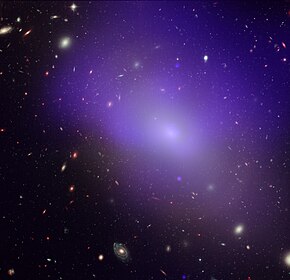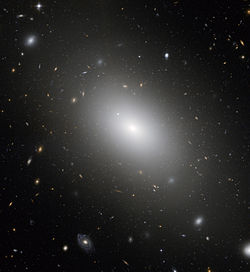| NGC 1132 | |
|---|---|
 A visible light image of NGS1132 with X-ray emission superimposed (rendered in blue) | |
| Observation data (J2000 epoch) | |
| Constellation | Eridanus |
| Right ascension | 02h 52m 51.82s[1] |
| Declination | −01° 16′ 29.0″[1] |
| Redshift | 6871 km/s[2] |
| Heliocentric radial velocity | 0.023189[2] |
| Distance | 263.9 Mly (80.91 Mpc)[3] |
| Apparent magnitude (B) | 13.9[2] |
| Characteristics | |
| Type | E[2] |
| Other designations | |
| UGC 2359, MCG +00-08-040, PGC 10891[2] | |
NGC 1132 is an elliptical galaxy located in the constellation Eridanus.[4] The galaxy was discovered by John Herschel on November 23, 1827.[5] It is located at a distance of about 318 million light-years away from Earth.[6]
NGC 1132 and nearby small galaxies are known as a "fossil group" that resulted from the merger of a group of galaxies.[4] It is the prototype example of the class of fossil galaxy groups.[7] The identification as a fossil group was made in 1999.[8] This group contains an enormous amount of dark matter and a large amount of hot gas that emits X-ray radiation.[9] The galaxy is surrounded by thousands of globular star clusters.[10]
One supernova has been observed in NGC 1132: SN 2024pbe (type Ia, mag. 17.8).[11]

See also
[edit]![]() Media related to NGC 1132 at Wikimedia Commons
Media related to NGC 1132 at Wikimedia Commons
References
[edit]- ^ a b Cutri, Roc M.; Skrutskie, Michael F.; Van Dyk, Schuyler D.; Beichman, Charles A.; Carpenter, John M.; Chester, Thomas; Cambresy, Laurent; Evans, Tracey E.; Fowler, John W.; Gizis, John E.; Howard, Elizabeth V.; Huchra, John P.; Jarrett, Thomas H.; Kopan, Eugene L.; Kirkpatrick, J. Davy; Light, Robert M.; Marsh, Kenneth A.; McCallon, Howard L.; Schneider, Stephen E.; Stiening, Rae; Sykes, Matthew J.; Weinberg, Martin D.; Wheaton, William A.; Wheelock, Sherry L.; Zacarias, N. (2003). "VizieR Online Data Catalog: 2MASS All-Sky Catalog of Point Sources (Cutri+ 2003)". CDS/ADC Collection of Electronic Catalogues. 2246: II/246. Bibcode:2003yCat.2246....0C.
- ^ a b c d e "NGC 1132". Simbad. Université de Strasbourg/CNRS. Retrieved September 24, 2020.
- ^ Tully, R. Brent; Courtois, Hélène M.; Sorce, Jenny G. (2016). "Cosmicflows-3". The Astronomical Journal. 152 (2): 21. arXiv:1605.01765. Bibcode:2016AJ....152...50T. doi:10.3847/0004-6256/152/2/50. S2CID 250737862. 50.
- ^ a b "Gargantuan galaxy NGC 1132 - a cosmic fossil?". Hubble Space Telescope. NASA/ESA. February 5, 2008. Retrieved September 24, 2020.
- ^ "New General Catalog Objects: NGC 1100 - 1149". cseligman.com. Retrieved 2020-09-25.
- ^ Nowakowski, Tomasz (June 27, 2017). "Galaxy NGC 1132 has a disturbed hot halo, study finds". Phys.org. Science X. Retrieved September 24, 2020.
- ^ Alamo-Martínez1, K. A.; West1, M. J.; Blakeslee, J. P.; González-Lópezlira, R. A.; Jordán, A.; Gregg, M.; Côté, P.; Drinkwater, M. J.; van den Bergh, S. (October 2012). "Globular cluster systems in fossil groups: NGC 6482, NGC1132, and ESO 306-017" (PDF). Astronomy & Astrophysics. 546 (A15): A15. arXiv:1208.4060. Bibcode:2012A&A...546A..15A. doi:10.1051/0004-6361/201219285. S2CID 59132846. Retrieved September 24, 2020.
{{cite journal}}: CS1 maint: numeric names: authors list (link) - ^ Martínez, Álamo; Adriana, Karla (2015). Globular Clusters: Jewels to Trace the Structure of Galaxies (PDF). Universidad Nacional Autónoma de México. p. 65. ISBN 9786070268106. Archived from the original (PDF) on 2022-07-09. Retrieved 2020-09-24.
- ^ "NGC 1132: A Mysterious Elliptical Galaxy". Chandra. NASA. February 5, 2008. Archived from the original on June 3, 2023. Retrieved September 24, 2020.
- ^ "The Gargantuan Galaxy NGC 1132". Hubble. ESA. February 5, 2008. Retrieved September 24, 2020.
- ^ Transient Name Server entry for SN 2024pbe. Retrieved 11 July 2024.
Well, that’s interesting to know that Psilotum nudum are known as whisk ferns. Psilotum nudum is the commoner species of the two. While the P. flaccidum is a rare species and is found in the tropical islands. Both the species are usually epiphytic in habit and grow upon tree ferns. These species may also be terrestrial and grow in humus or in the crevices of the rocks.
View the detailed Guide of Psilotum nudum: Detailed Study Of Psilotum Nudum (Whisk Fern), Classification, Anatomy, Reproduction